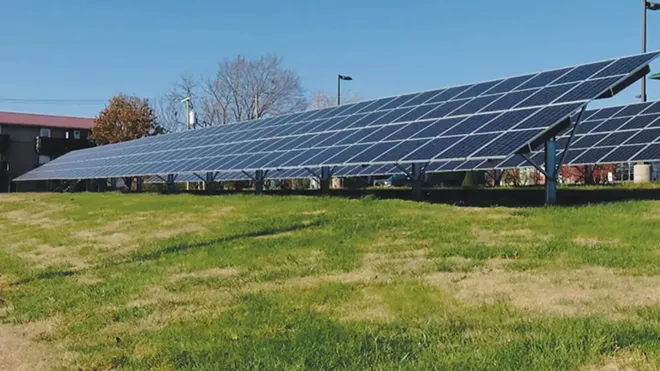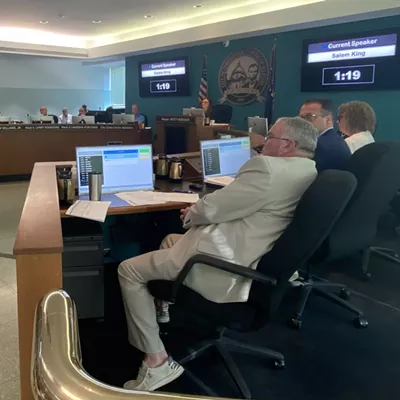President Donald Trump and congressional Republicans earlier this month curtailed federal tax incentives for the solar energy industry and for individuals and companies that purchase solar panels.
The move sent shockwaves through the industry nationwide, pulling key incentives for major projects and residential rooftop solar alike.
But in Illinois, members of the industry say state policy gives a bit of cover. While they have seen a wave of business before Biden-era tax breaks sunset, solar companies are left with uncertainty in the long-term.
Others fear Trump's actions will drive up prices by slowing the pace of renewables entering the market as fossil fuels exit for economic reasons.
The spending plan that Trump signed into law on July 4 will end several decades-old tax incentive programs between now and 2027. Those programs, which offer credits for rooftop solar systems and investment in large-scale projects, were expanded under the Inflation Reduction Act, a major initiative of former President Joe Biden.
Trump followed the bill signing with a July 7 executive order aimed at quickly ending any subsidies for "expensive and unreliable energy sources like wind and solar."
Between the spending bill and the executive order, the federal government will also stop offering a tax credit for the manufacture of wind power components and instead offer a similar subsidy to the coal used in steel production.
The new law also denies incentives to any projects that are owned by certain foreign entities or use a significant number of supplies from those entities, like the Chinese government and its affiliated businesses. This is particularly difficult for battery storage and solar projects, which often rely on minerals and components mined in or manufactured in China.
This leaves many consumer advocates and energy experts looking to Illinois to further insulate the industry, which is a key part of how the state plans to replace fossil fuel-generated electricity with carbon-free sources by 2045 as required by state law.
Energy price increase
The bill will likely result in higher energy prices across the country, according to an analysis from the REPEAT Project, a joint research effort by Stanford Professor Jesse Jenkins' Princeton Lab and Evolved Energy Research.
A separate analysis from think tank Energy Innovation, whose CEO was a senior Biden advisor involved in drafting climate change-related legislation, links the cost increases to a reduction in the number of renewable power plants that will be built under the new law.
This will affect electricity capacity markets directly as well as increase the wholesale price of natural gas due to the power sector's increased reliance on it. Federal data indicates natural gas is currently used for about 17.3% of all electricity generation in Illinois.
Estimates of the scale of the electric bill cost increase for a typical household vary. REPEAT pegs the increase at $280 per household per year by 2035 nationwide. Energy Innovation's model suggests $170 annual increase by 2035 and $180 in Illinois.
A spokesperson for the Citizens Utility Board, a consumer advocacy group in Illinois, echoed the sentiment and said ending the tax credit programs "is a gut punch to consumers and our economy."
Solar industry 'uncertainty'
Jon Carson, the managing partner at Trajectory Energy Partners, said the law is another part of the "solar coaster" – an industry euphemism about the ups and downs of solar tax credits. This part of the coaster, Carson said, will result in less investment.
"This change in law and the uncertainty from the president's executive order, it just means that less projects are going to get built in the short term," Carson said.
Carson, a longtime campaign and White House staffer under former President Barack Obama, founded Trajectory Energy Partners in 2017.
"We fundamentally believe that this is a real bump in the road for solar, it's a bump in the road for individual projects, but that ultimately the United States needs more power, and it's going to come from wind, solar and battery storage," he said, referencing three technologies Trump is against.
Others in the industry have raised flags that the "bump in the road" may be more obtrusive for some companies.
The investment tax credit that's ending under the new law offers a credit of 30% of project costs, with an optional 10% on top of that if a project meets certain labor standards. A similar tax credit exists for both residential and commercial projects.
Solar installation companies, customers and individuals still have time qualify for tax credits at the higher, Biden-era rates. Eligible projects must commence construction within the next 12 months or be placed in service by the end of 2027, almost a decade ahead of what was outlined in the IRA.
The rapid sunset has resulted in a short-term boom in requests for solar projects, according to Windfree Solar CEO Eric Heineman, whose Chicago-based company installs solar for commercial and residential projects.
"We don't know how it's going to impact us in the long term. What we know in the short term is that we know we have buyers who have been dragging their feet, they've got proposals for years with us, and now they're just coming out of the woodwork," Heineman said. "They're signing up left and right."
But even for projects started today, there's not a guarantee they will receive any tax benefits from the federal government. Trump's executive order signaled that his administration could revise guidance on what counts as the "beginning of construction."
Illinois' renewable haven
Illinois has increasingly subsidized the solar industry in recent years, most notably through the 2021 Climate and Equitable Jobs Act, or CEJA. That state law significantly expanded programs like Illinois Shines and Illinois Solar for All, which provide incentives to individuals and solar developers.
At a campaign stop while the Trump-backed spending plan was being considered in Congress earlier this month, Gov. JB Pritzker said Illinois' policy wouldn't be affected by the feds' repeal of Inflation Reduction Act tax credits.
"We put that bill together before the IRA was passed at the federal level, and so we anticipated that we needed to incentivize clean energy, and we did," Pritzker said on July 2.
Industry experts credit the state's policies generally, and CEJA specifically, for positioning the Illinois solar industry well as Trump's policies threaten solar broadly.
Heineman, who was former Gov. Pat Quinn's director of sustainability, pointed to the state's solar renewable energy credit, or SREC, programs as a driving factor.
"Our sales are our revenue. Sales are driven by SRECs. If we don't have revenue, we go out of business," Heineman said. "Illinois is more insulated than any other state in the country."
Heineman estimated that a typical solar project takes three years to pay for itself with current incentives. After the federal credit is repealed, it might take five years. Without state incentives, though, it could be as much as 10 years.
Capitol News Illinois is a nonprofit, nonpartisan news service that distributes state government coverage to hundreds of news outlets statewide. It is funded primarily by the Illinois Press Foundation and the Robert R. McCormick Foundation.












